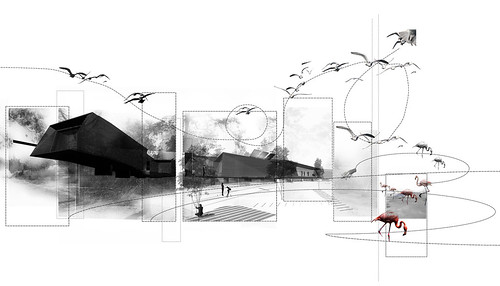
We treated the Info-Centre for the salt-lake (Alikes) in Larnaca, Cyprus more like a landscape project and less like an enclosed, self-contained building. The challenge was to intervene into a site of distinct beauty with a structure that would diffuse gently the human presence in nature. The intervention should help the users to make their visit a unique experience through the nature of the Alikes. A nature, which at the specific site is not one dimensional but varies, from a picnic area with clearings and paths, to a small but dense forest, to the open landscape of the salt lake.
For this reason the intervention will consist both of enclosed spaces that host material and services for information, as well as of open-air routes along the paths, through the trees up to the fringe where the sand of the salt-lake starts. Both the indoor and the outdoor spaces form an entity that expands like a bunch of stripes from the south-end of the site to its north-end. Along this bunch of movements the visitor experiences an alternation of indoors and outdoors experience, a continuous alternation of direction, which translates into a mixed experience of both fragments of information and fragments of the real landscape. This structure also renders the visit a creative introduction to the peculiarity of the landscape. The landscape is not openly offered to the view from the start of the visit, but is rather discovered during the process, as the visit advances, and is fully perceived at the end, as a revelation, when the visitor reaches the north-end of the building.
A shell, which covers the whole ensemble, acts as a second skin that unifies the distinct parts of the building. The shell consists of a wooden lattice, which produces a variant pattern according to the side of the building that the shell protects. In this way, this second skin creates special conditions for the building, by taking advantage of the sun position and the direction of the wind. Such a second skin and the use of the lattice is inspired from examples of the local traditional architecture, mainly churches.
By DRAFTWORKS!architects

Thanks for writing this topic, with so many details. Very useful and truly informative topic of Larnaca
ReplyDelete